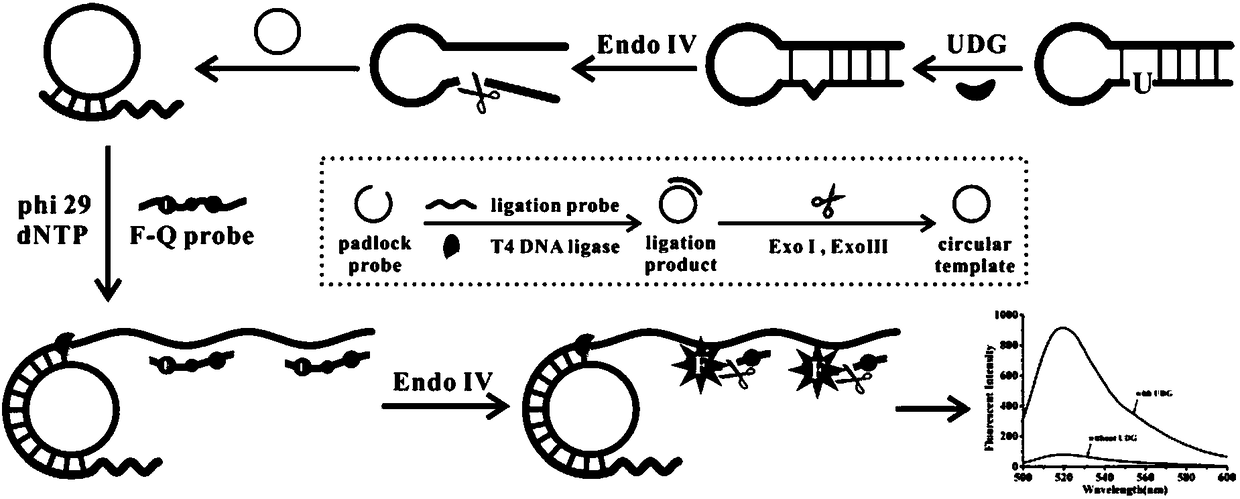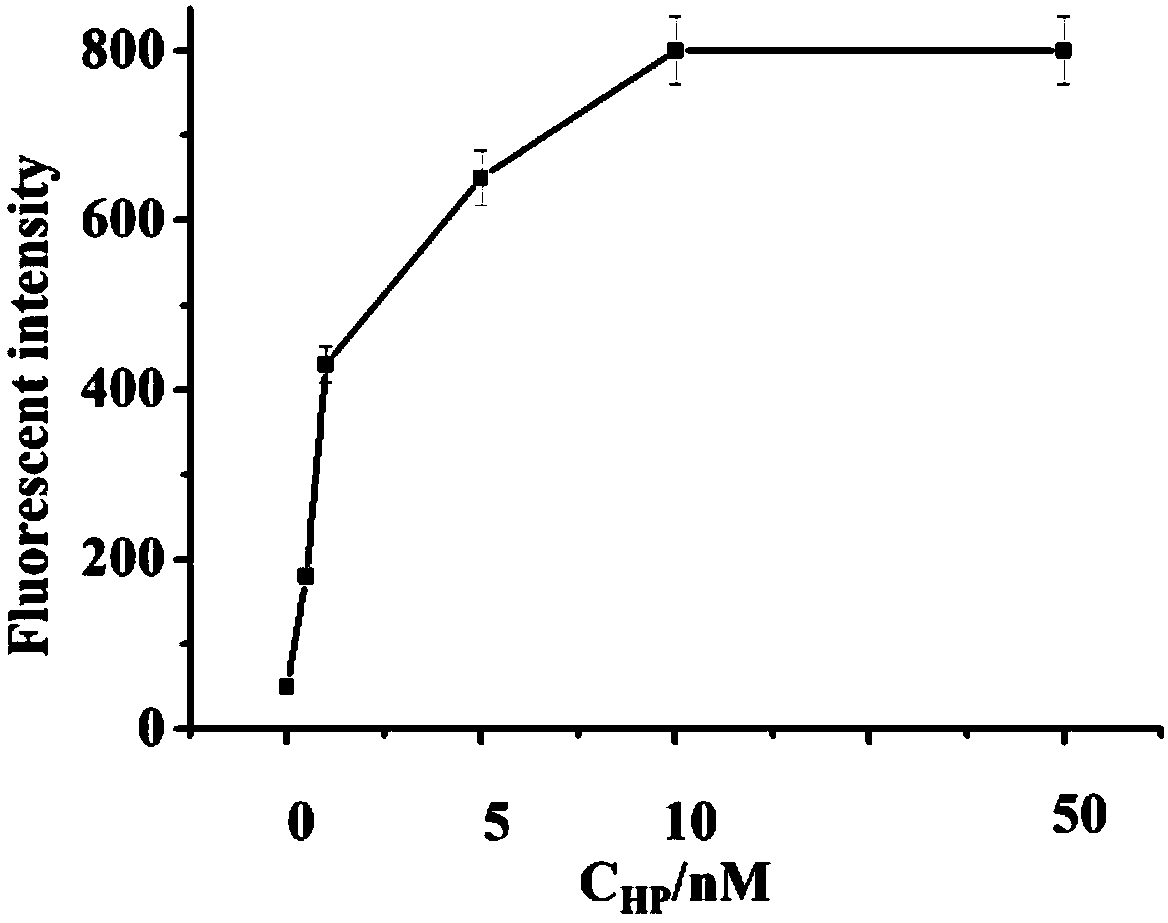Fluorescent biological sensor for detecting uracil-DNA glycosylase (UDG)
A biosensor and glycosylase technology, applied in the field of biosensors, can solve the problems of long detection period, low specificity and sensitivity, and achieve the effects of short detection period, good specificity and simple preparation method
- Summary
- Abstract
- Description
- Claims
- Application Information
AI Technical Summary
Problems solved by technology
Method used
Image
Examples
Embodiment 1
[0045] Example 1 Preparation of circular template.
[0046] Prepared with 50mM Tris-HCl, 10mM MgCl 2 , T4 DNA Ligase Reaction Buffer with 10 mM DTT and 1 mM ATP.
[0047] (1) Mix 42 μL sterilized water, 6 μL linear template (100 nM), 6 μL ligation probe (100 nM) and 6 μL 10× T4 DNA ligase buffer, denature at 95°C for 5 min, then Slowly cool down to room temperature to complete the hybridization, then add 3 μL of T4 DNA ligase (60 U / μL) to the reaction system, and react at 16°C for 20 hours; after that, the reaction system is placed in a water bath at 65°C for 15 minutes , inactivate the T4 DNA ligase in the system;
[0048] (2) Add 3 μL of exonuclease I (20 U / μL) and 3 μL of exonuclease III (100 U / μL) to the above reaction system and react at 37°C for 2 h; then place the reaction system in a water bath at 85°C Heated for 10 min to obtain a circular template, which was stored at 4°C for future use.
Embodiment 2
[0049] Example 2 The change of fluorescence intensity with the concentration of endonuclease IV.
[0050](1) Mix 3 μL circular template (10 nM), 3 μL hairpin probe (10 nM), 3 μL dNTP (1 mM), 2 μL phi29 DNA polymerase (1 U / μL), 2 μL endonuclease IV (The final concentrations are 1 U / mL, 5 U / mL, 10 U / mL, 20 U / mL, and 30 U / mL) in 3 μL phi29 DNA polymerase buffer, and then add 3 μL UDG enzyme solution (1 U / mL), after mixing, react at a constant temperature of 37°C for 90 min;
[0051] (2) Add 2 μL of fluorescent probe (10 μM) to the solution in step (1), mix well and react at a constant temperature of 37°C for 30 min;
[0052] (3) Take 32 μL of the solution obtained in step (2) and dilute it with water to 100 μL, and then perform fluorescence detection; set the excitation wavelength to 486 nm, the emission wavelength to 518 nm, and the detection range to 450 nm-530 nm, and read the change of the fluorescence signal .
[0053] See the test results figure 2 , it can be seen from...
Embodiment 3
[0054] Example 3 Fluorescence intensity changes with hairpin probe concentration.
[0055] (1) Mix 3 μL circular template (10 nM), 3 μL hairpin probe (final concentrations are 0.5 nM, 1 nM, 5 nM, 10 nM, 50 nM), 3 μL dNTP (1 mM), 2 μL phi29 DNA Mix polymerase (1 U / μL), 2 μL endonuclease IV (20 U / mL) in 3 μL phi29 DNA polymerase buffer, add 3 μL UDG enzyme solution (1 U / mL), mix well Afterwards, 37°C constant temperature reaction for 90 min;
[0056] (2) Add 2 μL of fluorescent probe (10 μM) to the solution in step (1), mix well and react at a constant temperature of 37°C for 30 min;
[0057] (3) Take 32 μL of the solution obtained in step (2) and dilute it with water to 100 μL, and then perform fluorescence detection; set the excitation wavelength to 486 nm, the emission wavelength to 518 nm, and the detection range to 450 nm-530 nm, and read the change of the fluorescence signal .
[0058] See the test results image 3 , it can be seen from the figure that with the increas...
PUM
 Login to View More
Login to View More Abstract
Description
Claims
Application Information
 Login to View More
Login to View More - R&D
- Intellectual Property
- Life Sciences
- Materials
- Tech Scout
- Unparalleled Data Quality
- Higher Quality Content
- 60% Fewer Hallucinations
Browse by: Latest US Patents, China's latest patents, Technical Efficacy Thesaurus, Application Domain, Technology Topic, Popular Technical Reports.
© 2025 PatSnap. All rights reserved.Legal|Privacy policy|Modern Slavery Act Transparency Statement|Sitemap|About US| Contact US: help@patsnap.com



